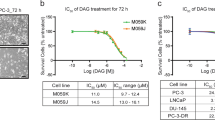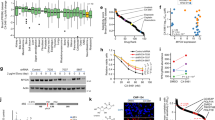Summary
Human topoisomerase II (hTopoII) inhibitors are important chemotherapeutic agents in many different settings including treatment of malignant mesothelioma. Topoisomerase poisons, such as etoposide and doxorubicin, function by trapping the DNA-enzyme covalent complex producing DNA strand breaks which can ultimately lead to cancer cell death, as well as development of secondary malignancies. While these compounds have been used successfully in treating a wide variety of cancers, their use against mesothelioma has been limited. This study evaluates the anti-proliferative activity of series of acridine-based catalytic inhibitors of hTopoII using four mesothelioma cell lines (H513, H2372, H2461, and H2596). The results indicate these compounds inhibit malignant cell proliferation with EC50 values ranging from 6.9 to 32 μM. Experiments are also performed that show that combination therapies may be used to increase potency. Based on the results of PARP cleavage and Guava Nexin assay, it is concluded that the primary mode of cell death is by apoptosis. The results are consistent with prior work involving pancreatic cancer and hTopoII catalytic inhibitors and suggest substituted acridines may hold promise in treating malignant mesothelioma.




Similar content being viewed by others
References
van Meerbeeck JP et al (2010) Malignant pleural mesothelioma: the standard of care and challenges for future management. Crit Rev Oncol Hematol
Teta MJ et al (2008) US mesothelioma patterns 1973–2002: indicators of change and insights into background rates. Eur J Cancer Prev 17(6):525–534
Price B (1997) Analysis of current trends in United States mesothelioma incidence. Am J Epidemiol 145(3):211–218
Vogelzang NJ et al (2003) Phase III study of pemetrexed in combination with cisplatin versus cisplatin alone in patients with malignant pleural mesothelioma. J Clin Oncol 21(14):2636–2644
Chattopadhyay S, Moran RG, Goldman ID (2007) Pemetrexed: biochemical and cellular pharmacology, mechanisms, and clinical applications. Mol Cancer Ther 6(2):404–417
Siddik ZH (2003) Cisplatin: mode of cytotoxic action and molecular basis of resistance. Oncogene 22(47):7265–7279
Laponogov I et al (2010) Structural basis of gate-DNA breakage and resealing by type II topoisomerases. PLoS One 5(6):e11338
Tan KB et al (1992) Topoisomerase II alpha and topoisomerase II beta genes: characterization and mapping to human chromosomes 17 and 3, respectively. Cancer Res 52(1):231–234
Olsen KE et al (2004) Amplification of HER2 and TOP2A and deletion of TOP2A genes in breast cancer investigated by new FISH probes. Acta Oncol 43(1):35–42
Jarvinen TA et al (2000) Amplification and deletion of topoisomerase IIalpha associate with ErbB-2 amplification and affect sensitivity to topoisomerase II inhibitor doxorubicin in breast cancer. Am J Pathol 156(3):839–847
Tsai CM et al (1990) Correlation of in vitro drug sensitivity testing of long-term small cell lung cancer cell lines with response and survival. Eur J Cancer 26(11–12):1148–1152
Syahruddin E et al (1998) Differential expression of DNA topoisomerase II alpha and II beta genes between small cell and non-small cell lung cancer. Jpn J Cancer Res 89(8):855–861
Larsen AK, Escargueil AE, Skladanowski A (2003) Catalytic topoisomerase II inhibitors in cancer therapy. Pharmacol Ther 99(2):167–181
Walker JV, Nitiss JL (2002) DNA topoisomerase II as a target for cancer chemotherapy. Cancer Invest 20(4):570–589
Deweese JE, Osheroff N (2009) The DNA cleavage reaction of topoisomerase II: wolf in sheep’s clothing. Nucleic Acids Res 37(3):738–748
Sadiq AA et al (2010) Anti-proliferative effects of simocyclinone D8 (SD8), a novel catalytic inhibitor of topoisomerase II. Invest New Drugs 28(1):20–25
Sahmoud T et al (1997) Etoposide in malignant pleural mesothelioma: two phase II trials of the EORTC Lung Cancer Cooperative Group. Eur J Cancer 33(13):2211–2215
Skubitz KM (2002) Phase II trial of pegylated-liposomal doxorubicin (Doxil) in mesothelioma. Cancer Invest 20(5–6):693–699
Goodell JR et al (2008) Acridine-based agents with topoisomerase II activity inhibit pancreatic cancer cell proliferation and induce apoptosis. J Med Chem 51(2):179–182
Goodell JR et al (2006) Synthesis and evaluation of acridine- and acridone-based anti-herpes agents with topoisomerase activity. Bioorg Med Chem 14(16):5467–5480
Oppegard LM et al (2009) Novel acridine-based compounds that exhibit an anti-pancreatic cancer activity are catalytic inhibitors of human topoisomerase II. Eur J Pharmacol 602(2–3):223–229
Akimitsu N et al (2003) Induction of apoptosis by depletion of DNA topoisomerase IIalpha in mammalian cells. Biochem Biophys Res Commun 307(2):301–307
Rene B et al (1997) Cytotoxicity and interaction of amsacrine derivatives with topoisomerase II: role of the 1′ substitute on the aniline nucleus. Bull Cancer 84(10):941–948
Degrassi F, Fiore M, Palitti F (2004) Chromosomal aberrations and genomic instability induced by topoisomerase-targeted antitumour drugs. Curr Med Chem Anticancer Agents 4(4):317–325
Andoh T, Ishida R (1998) Catalytic inhibitors of DNA topoisomerase II. Biochim Biophys Acta 1400(1–3):155–171
Chene P et al (2009) Catalytic inhibition of topoisomerase II by a novel rationally designed ATP-competitive purine analogue. BMC Chem Biol 9:1
Azarova AM et al (2007) Roles of DNA topoisomerase II isozymes in chemotherapy and secondary malignancies. Proc Natl Acad Sci U S A 104(26):11014–11019
Pentheroudakis G et al (2010) High levels of topoisomerase IIalpha protein expression in diffuse large B-cell lymphoma are associated with high proliferation, germinal center immunophenotype, and response to treatment. Leuk Lymphoma 51(7):1260–1268
Toyoda E et al (2008) NK314, a topoisomerase II inhibitor that specifically targets the alpha isoform. J Biol Chem 283(35):23711–23720
Ellis P et al (2006) The use of chemotherapy in patients with advanced malignant pleural mesothelioma: a systematic review and practice guideline. J Thorac Oncol 1(6):591–601
Chahinian AP et al (1993) Randomized phase II trial of cisplatin with mitomycin or doxorubicin for malignant mesothelioma by the Cancer and Leukemia Group B. J Clin Oncol 11(8):1559–1565
Khelifa T, Beck WT (1999) Merbarone, a catalytic inhibitor of DNA topoisomerase II, induces apoptosis in CEM cells through activation of ICE/CED-3-like protease. Mol Pharmacol 55(3):548–556
McLaren BR et al (2001) Expression and integrity of DNA topoisomerase II isoforms does not explain generic drug resistance in malignant mesothelioma. Cancer Chemother Pharmacol 48(1):1–8
Author information
Authors and Affiliations
Corresponding authors
Rights and permissions
About this article
Cite this article
Raza, A., Jacobson, B.A., Benoit, A. et al. Novel acridine-based agents with topoisomerase II inhibitor activity suppress mesothelioma cell proliferation and induce apoptosis. Invest New Drugs 30, 1443–1448 (2012). https://doi.org/10.1007/s10637-011-9720-7
Received:
Accepted:
Published:
Issue Date:
DOI: https://doi.org/10.1007/s10637-011-9720-7




